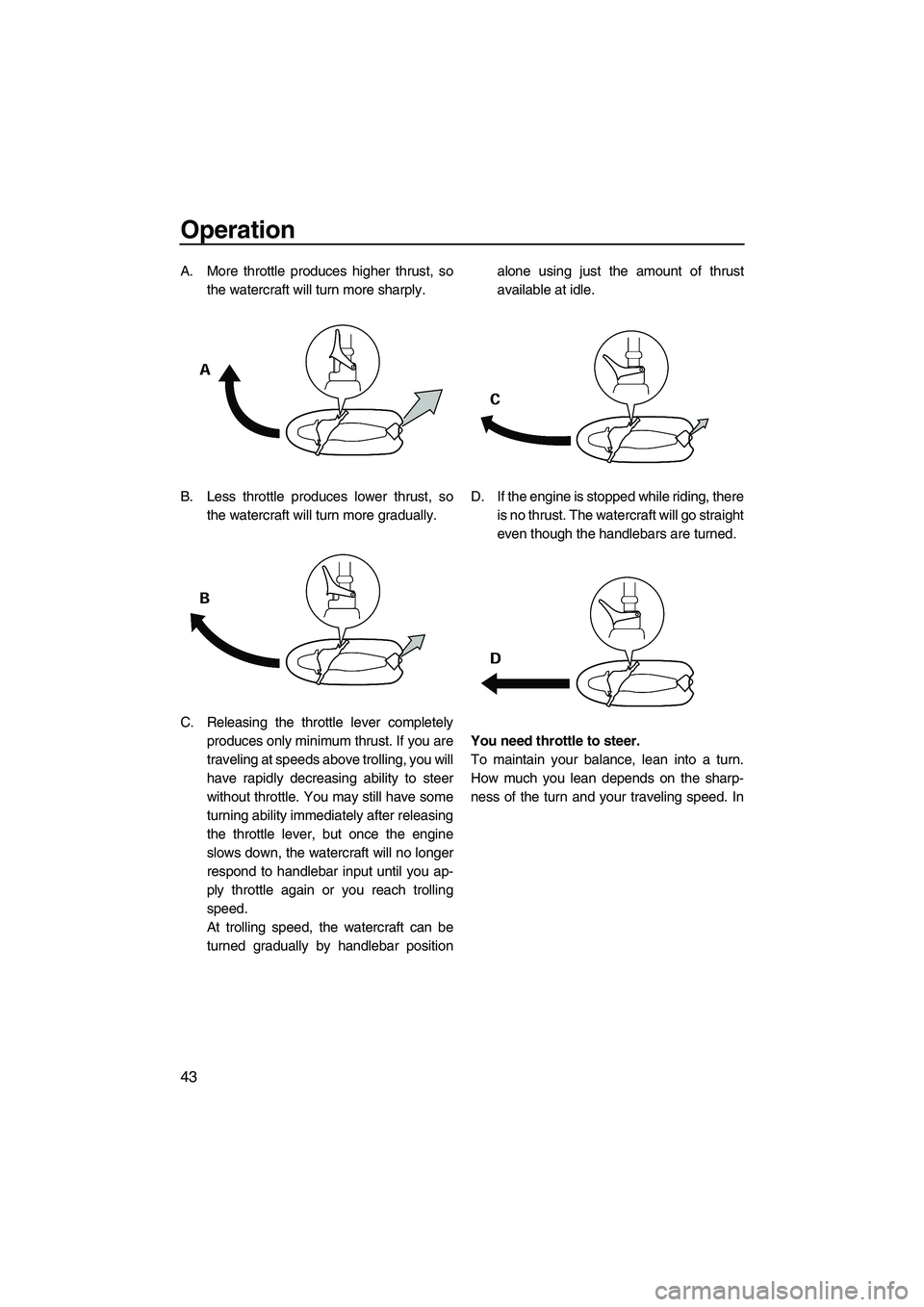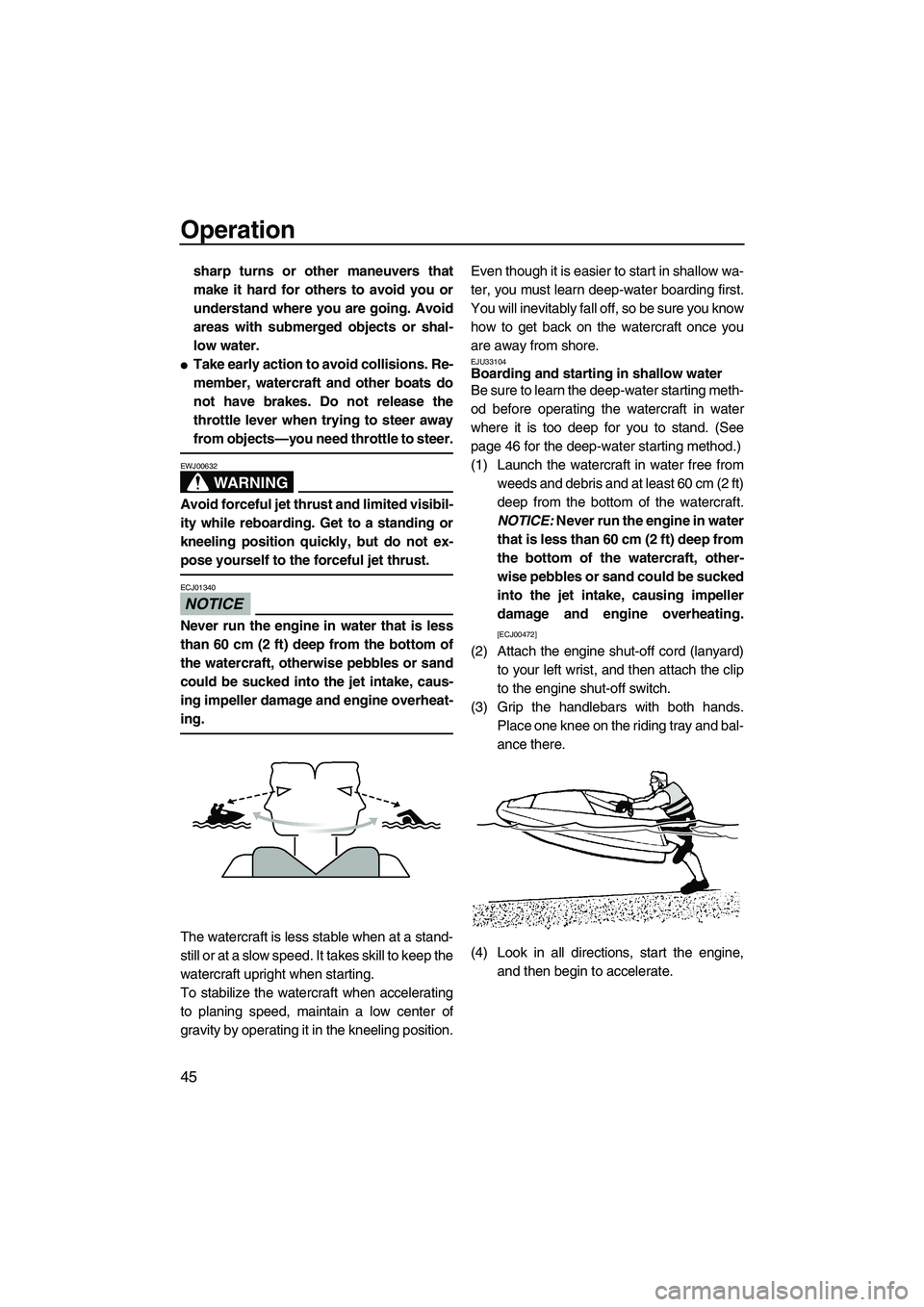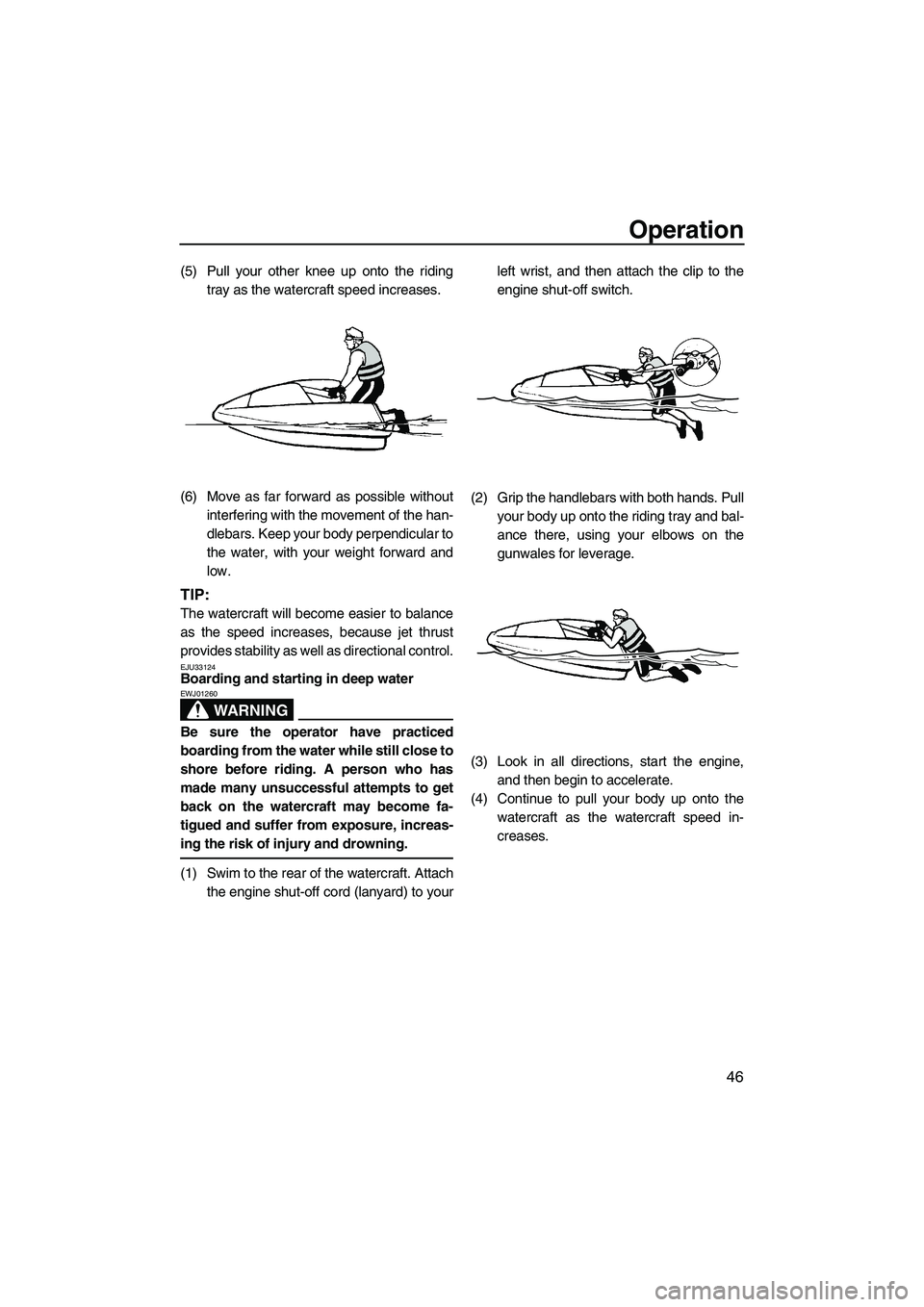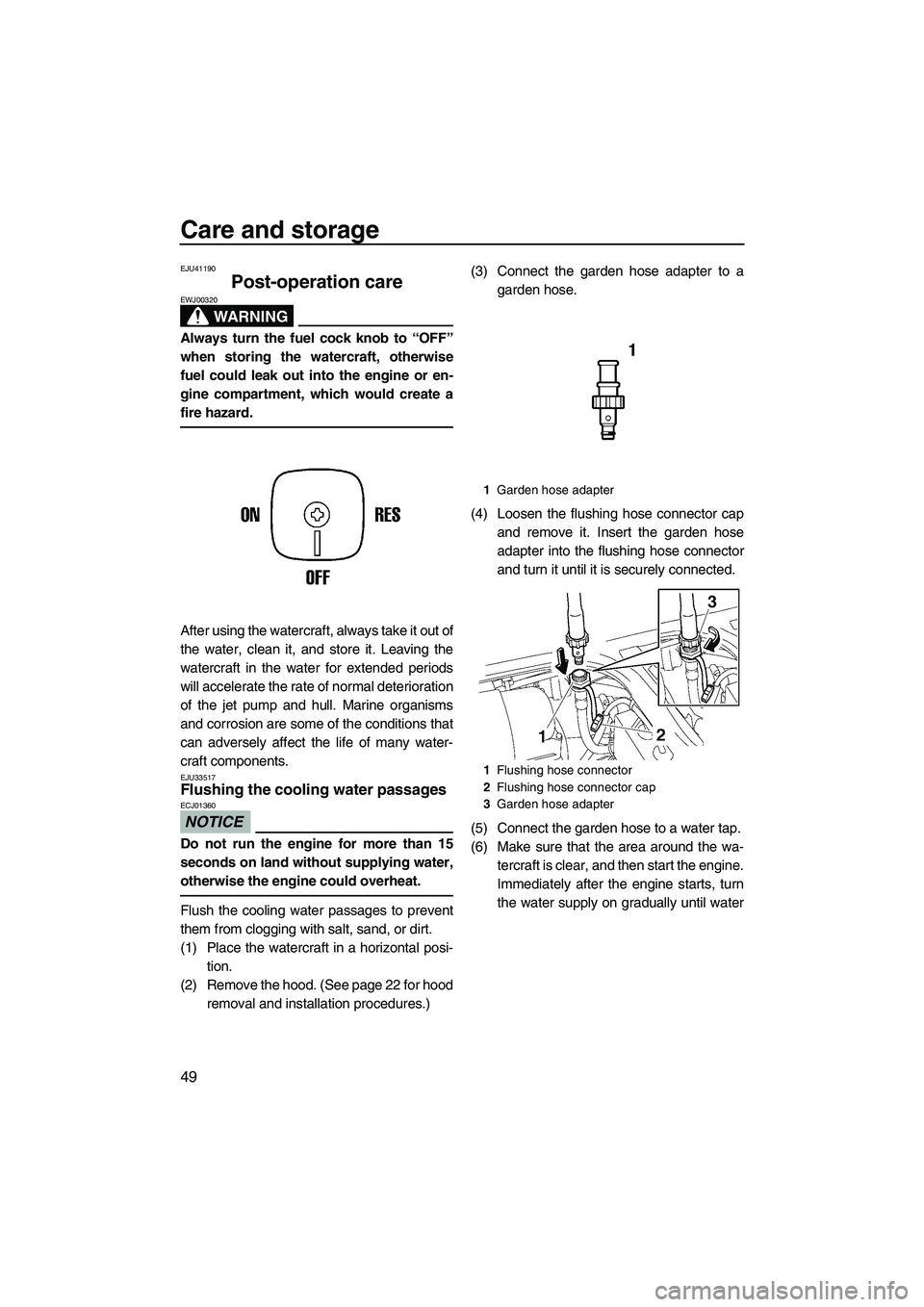Page 49 of 78

Operation
42
EJU32862Stopping the engine
Release the throttle lever, and then push the
engine stop switch (red button) to stop the en-
gine. WARNING! You need throttle to steer.
Shutting the engine off can cause you to
hit an obstacle you are attempting to
avoid. A collision could result in severe in-
jury or death.
[EWJ00601]
EJU32872
Leaving the watercraft
If leaving the watercraft, remove the clip from
the engine shut-off switch to prevent acciden-
tal starting or unauthorized operation by chil-
dren or others.
EJU41170Operating the watercraft
When the engine is running, the watercraft will
move forward even if the throttle lever is in thefully closed (idle) position and the engine is at
idling speed.
EJU33243Turning the watercraft
WARNING
EWJ00761
�Do not release the throttle lever when
trying to steer away from objects—you
need throttle to steer. A collision could
result in severe injury or death.
�When operating at higher speeds, make
gradual turns or slow down before turn-
ing. Sharp high-speed turns may cause
the watercraft to slide sideways or spin,
throwing the operator overboard, which
could cause an injury.
Steering control depends on the combination
of handlebar position and the amount of throt-
tle.
Water sucked in through the intake grate is
pressurized by the impeller in the jet pump. As
the pressurized water is expelled from the
pump through the jet thrust nozzle, it creates
thrust to move and steer the watercraft. The
higher the engine speed, the more thrust pro-
duced.
The amount of jet thrust, in addition to the po-
sition of the handlebars, determines how
sharply you turn.
UF2F72E0.book Page 42 Friday, May 22, 2009 5:11 PM
Page 50 of 78

Operation
43
A. More throttle produces higher thrust, so
the watercraft will turn more sharply.
B. Less throttle produces lower thrust, so
the watercraft will turn more gradually.
C. Releasing the throttle lever completely
produces only minimum thrust. If you are
traveling at speeds above trolling, you will
have rapidly decreasing ability to steer
without throttle. You may still have some
turning ability immediately after releasing
the throttle lever, but once the engine
slows down, the watercraft will no longer
respond to handlebar input until you ap-
ply throttle again or you reach trolling
speed.
At trolling speed, the watercraft can be
turned gradually by handlebar positionalone using just the amount of thrust
available at idle.
D. If the engine is stopped while riding, there
is no thrust. The watercraft will go straight
even though the handlebars are turned.
You need throttle to steer.
To maintain your balance, lean into a turn.
How much you lean depends on the sharp-
ness of the turn and your traveling speed. In
UF2F72E0.book Page 43 Friday, May 22, 2009 5:11 PM
Page 51 of 78

Operation
44
general, the higher the speed or the sharper
the turn, the more you lean.
EJU33272Stopping the watercraft
The watercraft is not equipped with a sepa-
rate braking system. It is stopped by water re-
sistance when the throttle lever is released.
From full speed, the watercraft comes to a
complete stop in approximately 90 m (300 ft)
after the throttle lever is released or the en-
gine is stopped, although this distance will
vary depending on many factors, including
gross weight, water surface conditions, and
wind direction. The watercraft slows down as
soon as the throttle lever is released, but will
coast for a distance before fully stopping. If
you are not sure you can stop in time beforehitting an obstacle, apply throttle and turn in
another direction.
WARNING
EWJ00722
�Allow adequate stopping distance.
�Take early action to avoid collisions. Re-
member, watercraft and other boats do
not have brakes.
�Operate defensively at safe speeds and
keep a safe distance away from people,
objects, and other watercraft to give you
time to stop.
�Do not shut the engine off when slowing
down in case you need engine power to
steer away from a boat or other obstacle
that comes into your path.
EJU33074Starting off
WARNING
EWJ00711
To avoid collisions:
�Scan constantly for people, objects, and
other watercraft. Be alert for conditions
that limit your visibility or block your vi-
sion of others.
�Operate defensively at safe speeds and
keep a safe distance away from people,
objects, and other watercraft.
�Do not follow directly behind watercraft
or other boats. Do not go near others to
spray or splash them with water. Avoid
UF2F72E0.book Page 44 Friday, May 22, 2009 5:11 PM
Page 52 of 78

Operation
45
sharp turns or other maneuvers that
make it hard for others to avoid you or
understand where you are going. Avoid
areas with submerged objects or shal-
low water.
�Take early action to avoid collisions. Re-
member, watercraft and other boats do
not have brakes. Do not release the
throttle lever when trying to steer away
from objects—you need throttle to steer.
WARNING
EWJ00632
Avoid forceful jet thrust and limited visibil-
ity while reboarding. Get to a standing or
kneeling position quickly, but do not ex-
pose yourself to the forceful jet thrust.
NOTICE
ECJ01340
Never run the engine in water that is less
than 60 cm (2 ft) deep from the bottom of
the watercraft, otherwise pebbles or sand
could be sucked into the jet intake, caus-
ing impeller damage and engine overheat-
ing.
The watercraft is less stable when at a stand-
still or at a slow speed. It takes skill to keep the
watercraft upright when starting.
To stabilize the watercraft when accelerating
to planing speed, maintain a low center of
gravity by operating it in the kneeling position.Even though it is easier to start in shallow wa-
ter, you must learn deep-water boarding first.
You will inevitably fall off, so be sure you know
how to get back on the watercraft once you
are away from shore.
EJU33104Boarding and starting in shallow water
Be sure to learn the deep-water starting meth-
od before operating the watercraft in water
where it is too deep for you to stand. (See
page 46 for the deep-water starting method.)
(1) Launch the watercraft in water free from
weeds and debris and at least 60 cm (2 ft)
deep from the bottom of the watercraft.
NOTICE: Never run the engine in water
that is less than 60 cm (2 ft) deep from
the bottom of the watercraft, other-
wise pebbles or sand could be sucked
into the jet intake, causing impeller
damage and engine overheating.
[ECJ00472]
(2) Attach the engine shut-off cord (lanyard)
to your left wrist, and then attach the clip
to the engine shut-off switch.
(3) Grip the handlebars with both hands.
Place one knee on the riding tray and bal-
ance there.
(4) Look in all directions, start the engine,
and then begin to accelerate.
UF2F72E0.book Page 45 Friday, May 22, 2009 5:11 PM
Page 53 of 78

Operation
46
(5) Pull your other knee up onto the riding
tray as the watercraft speed increases.
(6) Move as far forward as possible without
interfering with the movement of the han-
dlebars. Keep your body perpendicular to
the water, with your weight forward and
low.
TIP:
The watercraft will become easier to balance
as the speed increases, because jet thrust
provides stability as well as directional control.
EJU33124Boarding and starting in deep water
WARNING
EWJ01260
Be sure the operator have practiced
boarding from the water while still close to
shore before riding. A person who has
made many unsuccessful attempts to get
back on the watercraft may become fa-
tigued and suffer from exposure, increas-
ing the risk of injury and drowning.
(1) Swim to the rear of the watercraft. Attach
the engine shut-off cord (lanyard) to yourleft wrist, and then attach the clip to the
engine shut-off switch.
(2) Grip the handlebars with both hands. Pull
your body up onto the riding tray and bal-
ance there, using your elbows on the
gunwales for leverage.
(3) Look in all directions, start the engine,
and then begin to accelerate.
(4) Continue to pull your body up onto the
watercraft as the watercraft speed in-
creases.
UF2F72E0.book Page 46 Friday, May 22, 2009 5:11 PM
Page 54 of 78

Operation
47
(5) Bring your knees up onto the riding tray
and change to a kneeling position as
soon as you can do so.
(6) Move as far forward as possible without
interfering with the movement of the han-
dlebars. Keep your body perpendicular to
the water, with your weight forward and
low.
(7) Once the bow drops, and the watercraft
has leveled out in the water and reached
planing speed, back off the throttle and
select your desired speed.
TIP:
�The watercraft will become easier to bal-
ance as the speed increases, because jet
thrust provides stability as well as direction-
al control.
�It will take longer for a heavy operator to
reach planing speed than it will for a light
operator.
EJU33203Capsized watercraft
WARNING
EWJ00671
Improper uprighting can cause injury.
�Be sure to shut the engine off by pulling
on the engine shut-off cord (lanyard) to
remove the clip from the engine shut-off
switch.
�Do not put your hands in the intake
grate.
If the watercraft capsizes, turn it over immedi-
ately.
To upright the watercraft:
(1) Remove the clip from the engine shut-off
switch.
(2) Swim to the rear of the watercraft. Turn
the watercraft over clockwise.
If the port (left) side of the capsized wa-
tercraft is tilting up, push down on the
gunwale so that the port (left) side is
down before turning the watercraft clock-
wise. NOTICE: Do not turn the water-
craft over counterclockwise,
otherwise water can enter the engine,
which can result in severe damage.
[ECJ00541]
(3) Start the engine and operate the water-
craft at planing speed to drain water in the
engine compartment. (See page 28 for
water draining procedures. If the engine
does not start, see “Towing the water-
UF2F72E0.book Page 47 Friday, May 22, 2009 5:11 PM
Page 55 of 78

Operation
48
craft” on page 67 or “Submerged water-
craft” on page 67.) NOTICE: Do not run
the engine at full throttle for at least 1
minute after the engine has been re-
started. Bilge water in the engine com-
partment can splash into the engine,
which can result in severe damage.
[ECJ00553]
EJU33302
Beaching the watercraft
To beach the watercraft:
(1) Make sure that there are no boats, swim-
mers, or obstacles near the beach.
(2) Release the throttle lever to reduce
speed about 90 m (300 ft) before you
reach the intended beaching area.
(3) Slowly approach the beach and stop the
engine just before reaching land.
WARNING! You need throttle to steer.
Shutting the engine off can cause you
to hit an obstacle you are attempting
to avoid. A collision could result in se-
vere injury or death.
[EWJ00601] NOTICE:
Never run the engine in water that is
less than 60 cm (2 ft) deep from the
bottom of the watercraft, otherwise
pebbles or sand could be sucked into
the jet intake, causing impeller dam-
age and engine overheating.
[ECJ00472]
(4) Get off the watercraft and pull it up on the
beach.
EJU37192Operating in weeded areas
Always avoid using your watercraft in areas
where weed growth is thick. If operating in
weeded areas is unavoidable, alternately
squeeze the throttle lever to the full throttle
position and relax your grip on the throttle le-
ver to vary the engine speed. Weeds tend to
become clogged more when operating at a
steady speed and at trolling speed. If weeds
may have clogged the intake area, clean thejet intake. (See page 65 for jet intake cleaning
procedures.)
EJU41060After removing the watercraft from the
water
NOTICE
ECJ01360
Do not run the engine for more than 15
seconds on land without supplying water,
otherwise the engine could overheat.
After operating and removing the watercraft
from the water, promptly discharge the re-
maining water from the cooling water passag-
es.
To discharge water from the cooling water
passages:
(1) Make sure that the area around the wa-
tercraft is clear, and then start the engine.
(2) Discharge the remaining water out of the
cooling water passages by alternately
squeezing and releasing the throttle lever
quickly for 10 to 15 seconds.
(3) Stop the engine.
UF2F72E0.book Page 48 Friday, May 22, 2009 5:11 PM
Page 56 of 78

Care and storage
49
EJU41190
Post-operation care
WARNING
EWJ00320
Always turn the fuel cock knob to “OFF”
when storing the watercraft, otherwise
fuel could leak out into the engine or en-
gine compartment, which would create a
fire hazard.
After using the watercraft, always take it out of
the water, clean it, and store it. Leaving the
watercraft in the water for extended periods
will accelerate the rate of normal deterioration
of the jet pump and hull. Marine organisms
and corrosion are some of the conditions that
can adversely affect the life of many water-
craft components.
EJU33517Flushing the cooling water passages
NOTICE
ECJ01360
Do not run the engine for more than 15
seconds on land without supplying water,
otherwise the engine could overheat.
Flush the cooling water passages to prevent
them from clogging with salt, sand, or dirt.
(1) Place the watercraft in a horizontal posi-
tion.
(2) Remove the hood. (See page 22 for hood
removal and installation procedures.)(3) Connect the garden hose adapter to a
garden hose.
(4) Loosen the flushing hose connector cap
and remove it. Insert the garden hose
adapter into the flushing hose connector
and turn it until it is securely connected.
(5) Connect the garden hose to a water tap.
(6) Make sure that the area around the wa-
tercraft is clear, and then start the engine.
Immediately after the engine starts, turn
the water supply on gradually until water
1Garden hose adapter
1Flushing hose connector
2Flushing hose connector cap
3Garden hose adapter
UF2F72E0.book Page 49 Friday, May 22, 2009 5:11 PM